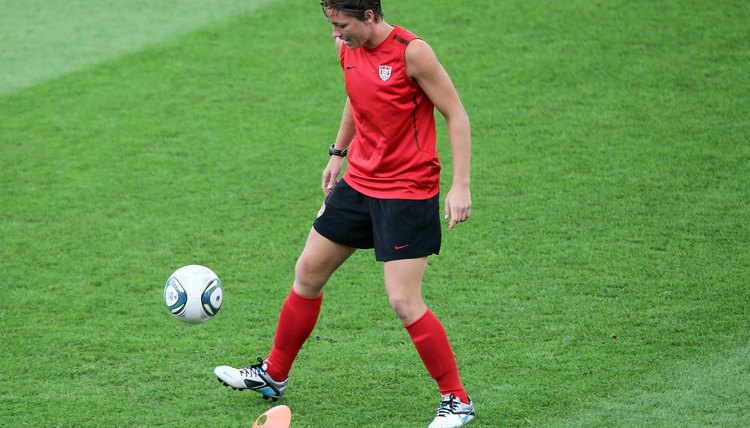10 Steps to Soccer Skills

When you first start playing soccer, it may seem like there is just one step to soccer success -- kicking the ball to a teammate or into the goal. But as you get more into the game, you’ll want to master the fine points that take you far past the child’s play aspect of basic soccer and into overall mastery. A 10-step program provides a conceptual framework to emulate what top soccer academies teach and helps you achieve greater impact on the field.
Balance
Soccer starts with an underrated step to success -- good balance. “Everything you do in soccer -- pass, trap, shoot, reverse turns -- requires proper balance on the plant foot. Not enough attention is paid at the basic level to balance,” says Wes Harvey, a Maryland-based coach of men’s, women’s and children’s soccer programs. Children can work on balance with the airplane pose, standing on one leg, torso bent forward, arms extended and the raised leg horizontal behind the body. Adults can improve their balance in the course of practicing the basic skills of soccer.
Dribbling, Shielding and Tackling
Especially for beginning players, dribbling serves as the main way to advance the ball. You can practice by tapping the ball forward with the inside, outside or top of your cleats, or weave the ball through a row of cones. Shielding involves protecting the ball by keeping your body between the opponent and the ball. Tackling has a different meaning in soccer than to its meaning in American football. In soccer, you tackle by chipping the ball away from an opponent with a toe poke, a slide on the ground or by blocking the ball with your foot or lower leg.
Passing and Trapping
Youth players quickly learn that passing advances the ball more quickly than the fastest dribble. Trapping refers to gently controlling a pass -- some coaches refer to this as “receiving” the ball. You can practice passing and trapping with a partner, just kicking the ball back and forth on the ground. Advanced players move on to traps with the chest and trapping aerial or “flighted” balls, as well as ground balls.
Shooting and Heading
Learning to shoot the ball helps you to win games. You can shoot if you are close to the goal by simply striking the ball into the net, away from the goalkeeper. Shooting from a distance requires a lot of practice and aiming to place the ball in the corners of the goal. “Your emphasis should be on shot location first, and power second,” Harvey notes. You can also head the ball in the goal by snapping your upper body forward so the top of the forehead smacks the ball in. Heading can also be used in place of a pass to advance the ball to a teammate or as a defensive maneuver.
Teamwork and Specialized Skills
To apply your skills, you need to work as part of a team. Give-and-go drills and two-touch games -- allowing each player only to trap the ball and then pass it -- teach offensive teamwork. Team defense entails positioning yourself to either closely mark the ball carrier or shut off potential passes to opponents near the ball. Finally, specialized skills include working on throw-ins, goalkeeping and taking penalties and free kicks. Older youth players and adults need to undertake all 10 steps to master soccer skills and become a well-rounded player.
References
- Wes Harvey; Soccer Coach; Baltimore, Maryland
- Science of Soccer Online: Soccer Training Improves Balance In Adults
- Soccer: Steps to Success; Joe Luxbacher
Writer Bio
An award-winning writer and editor, Rogue Parrish has worked at the Washington Post, the Baltimore Sun and at newspapers from England to Alaska. This world adventurer and travel book author, who graduates summa cum laude in journalism from the University of Maryland, specializes in travel and food -- as well as sports and fitness. She's also a property manager and writes on DIY projects.
